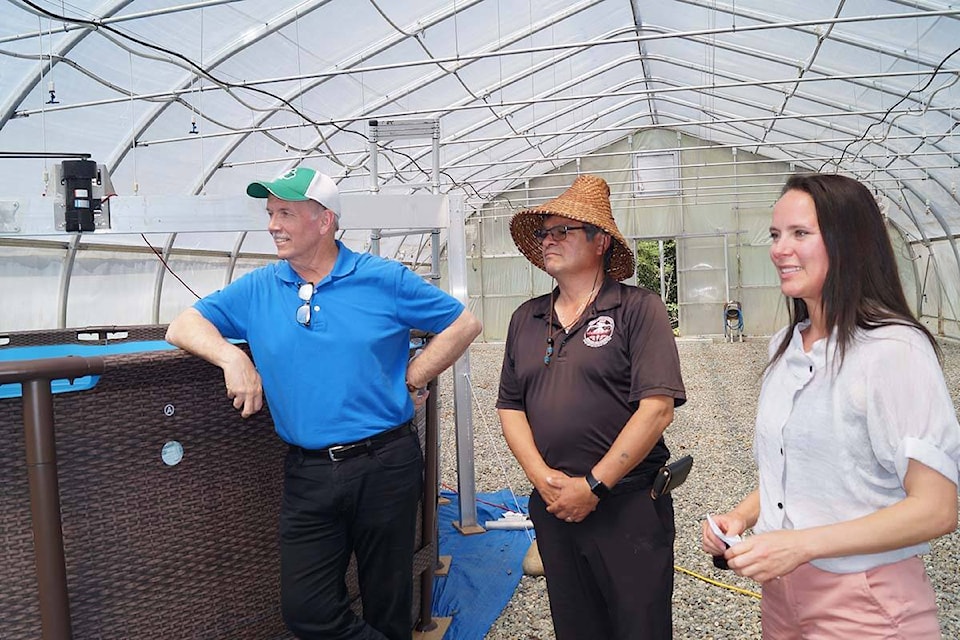A proposal to reduce cow flatulence is clearing the air after creating a bit of a stink in its southern Vancouver Island neighbourhood.
Calgary-based Synergraze Inc. has combined forces with the T’Sou-ke First Nation in the production of a livestock feed additive that could significantly reduce methane emissions from cattle, sheep, chickens, bison and sheep.
In greenhouses in Sooke, west of Victoria, a demonstration project is producing seaweed and algae in tanks harvested from seeds from the ocean that are then used as a livestock feed additive that can drastically reduce methane emissions.
“We’re producing something that can have a global impact while making Canadian cattle producers more competitive,” Synergraze Inc. chief operating officer Tamara Loiselle said. “One cow, on average, produces one ton of CO2 equivalent a year. Using a tiny bit of additive with just B.C. cattle would eliminate the equivalent of one million cars on the road a year.”
Emissions from cattle account for 30 per cent of all methane emissions globally. Although methane is the second most abundant greenhouse gas emitted into the atmosphere by human activity after carbon monoxide, it is 25 times more potent as a heat-trapping gas than carbon dioxide.
The company states that by significantly reducing methane emissions from cattle, Synergraze can assist Canada and the provinces in meeting their methane emissions reduction targets while helping farmers and consumers of meat and dairy products to become part of the solution to global warming.
“If 40 per cent of Canada’s cattle were supplemented with Synergraze, methane emissions from cattle could be reduced by approximately (tonnes of CO2e per year). This is equivalent to removing over four million vehicles off the road every year,” the statement said.
ALSO READ:
Despite its environmental focus, Loiselle says several misconceptions have been spread about the company’s proposal for a facility in East Sooke.
One of several concerns being repeated on social media is that the seaweed species to be cultured may be asparagopsis, an invasive species.
“The land-based aquaculture farm is not a farm,” a complaint from Summer Conrad to the Agricultural Land Commission state. “It is an industrial complex of land structures which may be designed to propagate a potentially invasive species of algae, asparagopsis, with the risk of introduction into the Sooke Basin, JDF electoral area.”
Loiselle stressed in an interview with Black Press Media that asparagopsis is not part of the equation.
“We will be using Pacific seaweeds/algae found naturally in the region,” Loiselle said. “Synergraze is planning an aquaculture facility, not an industrial one, and bears no resemblance to facilities (referred to by Conrad) in Australia.”
In an interview with the Black Press Media, Conrad said residents want an oversight committee or mechanism to monitor the project and want to see a detailed description of what’s involved in the project and what it will look like
She said other concerns include the scope and scale of the project, the number of buildings involved, a description of what the site will look like, the types and numbers of pools, and determining what specific algae will be produced.
“It feels like we’re being asked to approve a building without seeing what the plans look like,” said Conrad, an East Sooke resident with a background in planning and architecture.
Synergraze Inc. and the T’Sou-ke Nation released a joint statement last week in an attempt to assuage concerns.
According to the statement, no warm water will enter the Sooke Basin and the project will not negatively impact it.
Synergraze permit applications have undergone rigorous evaluation, including environmental evaluations from multiple government departments at the provincial and federal levels, the statement noted.
The company also wanted to clarify that it has never applied to the Capital Regional District for a dumping permit and has no intention of doing so and that there is no connection between Synergraze and Trans Canada Pipelines.
Representatives from Synergraze and T’Sou-ke Nation conducted several tours recently in an attempt to clear up misconceptions about the project.
Every resident of East Sooke that signed up through the Synergraze website or via email expressing interest or concerns about the project was invited to tour the pilot facility at the greenhouse at T’Sou-ke nation land, Loiselle said.
“They all received an invitation to tour the facility and meet with T’Sou-ke Nation Chief (Gordon) Planes and me during the week of Jan. 16. The reaction from most people was very positive.”
Planes said he believed those who took the tours came away with a much better understanding of the project.
“We’re not even out in the basin yet, and people are getting ahead of themselves,” he said. “You’re not going to change everyone’s minds, but most people who took the tour were impressed. I strongly support the work of Synergraze and see it as a great opportunity to help Mother Earth.”
RELATED:
news@sookenewsmirror.com
Like us on and follow us on




